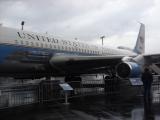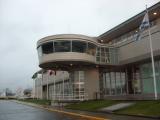
































































In January, 2011, Jen and I were in western Washington visiting family. We took an afternoon outing to the Museum of Flight at Boeing Field in Seattle. The gallery space in the museum is about 50% larger than the Smithsonian National Air and Space Museum gallery on the Mall in Washington, D.C.
These photos are copyright © 2011 Kenneth E. Harker. All rights reserved.
 |
The Museum of Flight main entrance. |
 |
Just outside the main museum entrance is a Mikoyan-Gurevich MiG-17. A Soviet jet fighter aircraft of the 1960s, this one is painted in the standard markings of a North Vietnamese fighter aircraft. |
 |
A model of a Da Vinci glider design, hanging near the ticket counter inside. |
 |
This is a reproduction of a Rumpler Taube, a German aircraft that entered production in 1910. Some Taubes were used as scout planes in World War I, but were relegated to a training role early in the war. |
 |
A full-size model of Sputnik 1. |
 |
The main atrium in the center of the museum is full of historical aircraft. The biggest one is the Lockheed M-21 Blackbird, with the attached unpiloted drone. The M-21 was an earlier version of the more famous SR-71 model. |
 |
The aircraft suspended from the ceiling were mostly of the lighter variety. The aircraft with the mannequin inside is the MacCready Gossamer Albatross II. |
 |
This is the MacCready Goassamer Albatross II. This aircraft was a backup duplicate of the original Albatross, the first human-powered aircraft to cross the English Channel. The Albatross II would later make the first human-powered flight inside a structure, the Houston Astrodome. |
 |
This is aircraft is called the Insitu Aerosonde Laima. In 1998, this aircraft beacme the first unmanned aircraft to cross the Atlatnic Ocean. |
 |
One of the Lockheed M-21 Blackbird engines. |
 |
Looking down the Lockheed M-21 Blackbird engine. |
 |
Another view of the Lockheed M-21 Blackbird's engine. |
 |
The underside of the Lockheed M-21 Blackbird. There are gaps in the panels because the titanium skin of the aircraft will heat up during flight and expand. |
 |
The business end of a McDonnell F-4C Phantom II. The Phantom was an important combat aircraft for the United States in the Vietnam War. |
 |
The Lockheed F4C Phantom II could carry a variety of missles and bombs. |
 |
Nose art on the Lockheed F4C Phantom II. |
 |
Looking down the nose of a Mikoyan-Gurevich MiG-21 PFM. One of the best known Soviet jet fighters, it was a contemporary of the Lockheed F4C Phantom II. |
 |
Another view of the Mikoyan-Gurevich MiG-21 PFM. |
 |
The Godyear F2G1 Super Corsair was a World War II aircraft that saw service in the Pacific theater. |
 |
The most distinctive feature of this aircraft is the gull wings that hinge to fold up. This enabled the aircraft to be stored more efficiently on aircraft carriers. |
 |
A Mikoyan & Gurevich MiG-15. This particular aircraft belonged to the People's Liberation Army and was modified by the Chinese from the standard Russian model. |
 |
The MiG-15 entered service in the Soviet military just in time for the beginning of the Korean War. |
 |
The nose cone of the MiG-15. |
 |
The Grumman F9F Cougar. This jet fighter entered service during the Korean War. |
 |
The Douglas A4F Skyhawk. The Skyhawk first entered service after the Korean War and flew combat missions for the Navy and the Marines in the Vietnam War. This particular jet was flown by the Navy's Blue Angels. |
 |
A Fieseler V1 flying bomb from World War II. This was the world's first cruise missle. It was launched from an aircraft and flew unpiloted to its target. |
 |
Various aircraft in the main gallery. |
 |
Outside the main museum facility, the museum has a variety of larger aircraft, including a Concorde Supersonic Airliner in an area called the Airpark. This particular Concorde was the last one to fly a commercial flight, for British Airways, in 2003. |
 |
The nose of the Concorde. This aircraft was capable of operational speeds twice the speed of sound. On the way to the museum, it traveled from New York to Seattle in under an hour. |
 |
This view is the underside of the Concorde. |
 |
Massive air scoops under the wings of the Concorde Supersonic Airliner. |
 |
The tail of the Concorde Supersonic Airliner. |
 |
Also outdoors was a retireed Air Force One. Air Force One is the radio call sign assigned to the aircraft of the President of the United States. This particular aircraft was a Boeing 707-120, heavily customized for use by the President. |
 |
A conference table inside Air Force One. This particualr aircraft entered service as Air Force One in 1959, when Dwight. D. Eisenhower was President, and was replaced by a newer aircraft in 1962, during the Presidency of John F. Kennedy. |
 |
This desk was equipped with a telephone and early facsimile machine. |
 |
The communications console on Air Force One was full of every imaginable radio transceiver and receiver from the late 1950s. |
 |
The kitchen aboard Air Force One. |
 |
The tour through Air Force One exits out the front door. |
 |
The outdoor exhibit area was across the street from the main museum exhibit halls, with a connecting walkway. |
 |
Back inside the museum, we checked out the World War I and World War II warbirds. This is a Caproni Ca.20 This Italian plane is considered the first military fighter aircraft, and was equipped with a single machine gun mounted high above the propellor. The Italian army did not see the value of a fighter aircraft, however, and this was the only one Caproni ever produced. |
 |
This is a reproduction of a Royal Aircraft Factory S.E.5a, a British biplane fighter from World War I. |
 |
This is a Sopwith Triplane, another British fighter from World War I. The three wings on the triplane made it exceptionally maneuverable. This aircraft is also a reproduction. |
 |
The distinctive nose on this Nieuport 28 C.1 fighter is painted in the scheme used by American fighter pilot Quentin Roosevelt, son of former U.S. President Theodore Roosevelt, who was killed in action flying a Nieuport 28 C.1 in World War I. Although a French aircraft, almost all of them were flown by the U.S. Army. |
 |
This is a reproduction of a SPAD XIII, a French fighter aircraft from World War I that entered service only in early 1918. |
 |
This is a reproduction of a Curtiss Jenny. The Jenny was a training aircraft that never saw comabt in World War I, but did serve the U.S. Army in Mexico in 1916 during operations against Pancho Villa. This particular aircraft was built in the 1980s from surplus parts left over when the production of the aircraft was discontinued. |
 |
Looking down on a reproduction of a Fokker D.VIII, a German fighter plane from World War I. An advanced monoplane design, the aircraft entered service late in the war, in 1918. |
 |
This is a Supermarine Spitfire Mk IX. |
 |
The Spitfire was an iconic fighter aircraft of Great Britain in the second World War. |
 |
A Messerschmitt BF-109E, one of the most commonly used German fighter aircraft in World War II. |
 |
This is a Curtis P-40N Warhawk. This particular aircraft is painted in the colors used by the "Flying Tigers" fighting against the Japanese in China during World War II. |
 |
The "Flying Tigers" were known for their distinctive nose art. |
 |
A view of the big air scoop just behind the propellor of the Curtis P-40N Warhawk. |
 |
This aircraft is a reproduction of the Nakajima Ki-43-IIIa Hayabusa, a Japanese army fighter aircraft in World War II. |
 |
Allied pilots called this aircraft "Oscar", and they were the most widely used aircraft of the Japanese army in the war. |
 |
This is a Brewster F2A Buffalo. It was one of the first monoplanes to enter service with the US Navy, and only saw limited action in combat. |
 |
The propellor end of the Brewster F2A Buffalo. |
 |
This is a Goodyear FG-1D Corsair. Basically the same aircraft as the Chance Vought F4U Corsair, these aircraft saw wide service with the US Navy and Marine Corps in World War II. The Corsair was even used in combat during the Korean War. |
 |
The nose art on a Republic P-47D Thunderbolt. The P-47 was the most produced American fighter aircraft in World War II. |
 |
This particular Republic P-47D Thunderbolt is one that served in a Latin American air force after World War II, as part of U.S. military assistance packages. It's currently livery resembles that of a P-47D that would have seen combat in World War II. |
 |
This is a Russian Yakovlev Yak-9U fighter from World War II. This particular aircraft is quite rare - one of only four Yak-9Us known to exist. |
 |
The tiger design on the Yakovlev Yak-9U replicates the markings of a famous Russian ace, General Maesky. |
 |
This is a North American P-51D Mustang. The Mustange was one of the most successful long-range fighters in the United States Army Air Corps in World War II. A striking feature of the aircraft was the bubble canopy. |
 |
This is a Lockheed P-38L Lightning. The Lightning was a unique fighter in that it had two fuselages and two engines, with the cockpit in a third pod between them. Most Lightnings saw service in U.S. Army Air Corps in the Pacific Theater of World War II. |
 |
A huge collection of model aircraft from World War II, mostly 1:72 scale. |
 |
Outside the museum, this room sticking out away from the building contained a simulated aircraft controller tower operation room and offered a good view of the Boeing Field runway. |
| Last Updated 1 August 2018 |